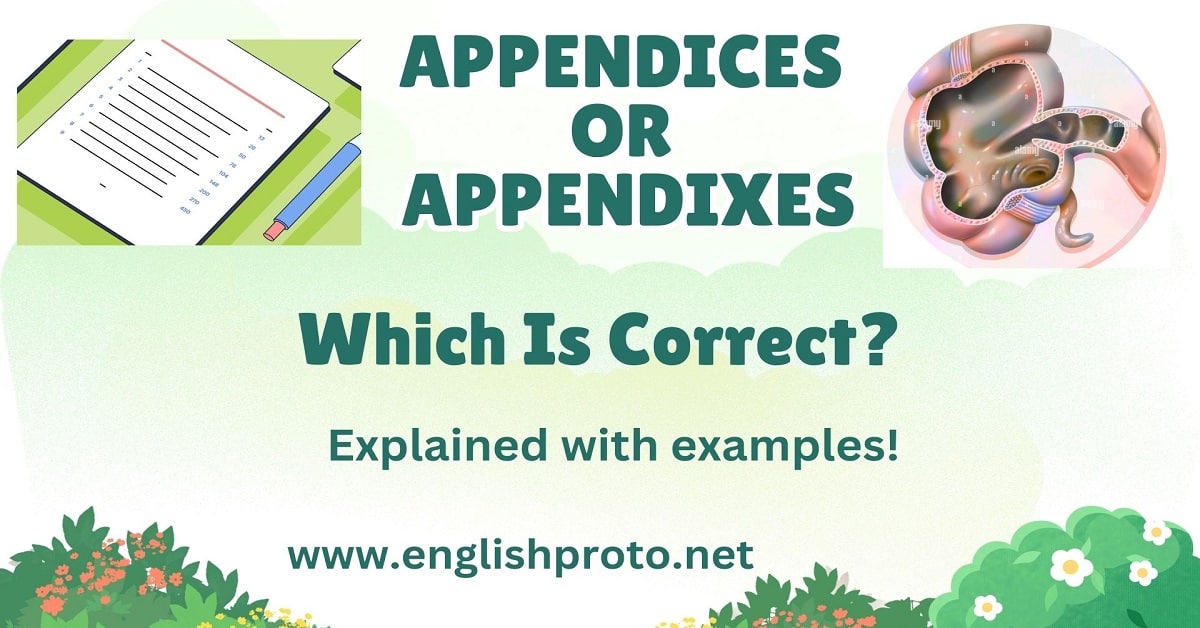Appendices or Appendixes? If you’ve ever found yourself second-guessing which plural form to use, you’re not alone! It’s one of those tricky language choices that can trip up even seasoned writers.
You might be working on a report, research paper, or any other document and suddenly realize you’re unsure whether to use “appendices” or “appendixes.”
Don’t worry, by the end of this article, you’ll not only understand the difference but also know how to use these terms confidently. Stick around to clear up the confusion and elevate your writing with one simple tip that will make your documents look more polished!
Quick Summary
- Appendices and appendixes both refer to supplementary material added at the end of a document, often used in books, research papers, reports, and academic works.
- The correct plural form is generally appendices, though appendixes is also an accepted variant in English.
- The term “appendix” itself refers to an additional section in a book or document, usually containing detailed or supplementary information.
Key Takeaways
- “Appendices” is considered the more formal and widely accepted plural form.
- “Appendixes” is technically correct but less commonly used.
- Both forms are grammatically acceptable, but using “appendices” tends to be preferred, especially in academic and professional contexts.
Reasons for Confusion
One reason why “appendices” and “appendixes” cause confusion lies in their similarities to other plural forms in the English language. In many cases, the plural form of words ending in -ix becomes -ices (e.g., index → indices, matrix → matrices). This pattern leads many writers to automatically assume that the plural of “appendix” should follow the same rule and be spelled as “appendices.”
Moreover, some writers might mistakenly believe there’s a regional divide between the two forms, with “appendices” being preferred in British English and “appendixes” used in American English. However, this is not strictly the case, and both forms are widely understood and accepted in various English-speaking regions.
⚡ Quick Tip:
When in doubt, default to “appendices” in formal writing, as it is more commonly recognized and accepted.
Detailed Explanation
What Are Appendices?
The term appendix refers to supplementary material that is added at the end of a book, article, report, or academic paper. This additional material is typically related to the content of the document but is not essential for its main argument. An appendix might contain:
- Detailed charts or tables
- Extended data sets
- Additional explanations or definitions
- References to sources or related works
- Glossaries or lists of terms
The plural form of appendix is used when referring to multiple pieces of supplementary material.
The Correct Forms: Appendices vs. Appendixes
As mentioned, appendices is the plural form that most writers prefer, especially in formal and academic contexts. It follows a classical Latin pluralization rule, where words ending in -ix (like appendix) take the plural -ices. This pattern is common in Latin-derived words and contributes to the formality of the term.
On the other hand, appendixes follows a more straightforward English pluralization rule, where words ending in -x typically add an -es to form their plural. Although this form is technically correct, it is less favored in academic and formal writing, where “appendices” prevails.
Is One Form Better Than the Other?
Both appendices and appendixes are grammatically correct, but the more formal and preferred choice is generally appendices, especially when you’re writing for an academic, professional, or formal audience.
The use of appendices aligns with the historical, Latin-based conventions of the English language, making it a more sophisticated and polished option.
In contrast, appendixes is a perfectly acceptable plural form, though it’s typically considered less formal and may feel slightly out of place in highly professional or scholarly documents.
Common Errors
Despite the relatively straightforward rules for these terms, several common errors persist. Let’s take a look at some of these mistakes and why they should be avoided:
1. Using “Appendix” as a Plural Form
One of the most common errors is mistakenly using appendix as a plural term. For example:
- Incorrect: “The appendices of the report are detailed on the following pages.”
- Correct: “The appendices of the report are detailed on the following pages.”
Here, “appendix” is mistakenly used to refer to more than one supplementary section. The correct plural form is appendices.
2. Confusing “Appendices” with “Appendix’s”
Another frequent error is using the possessive form appendix’s in place of the plural appendices. For example:
- Incorrect: “The appendix’s are provided at the end of the document.”
- Correct: “The appendices are provided at the end of the document.”
This error arises from confusing the possessive form (used to show ownership) with the plural form.
3. Overuse of “Appendixes”
While “appendixes” is not incorrect, overusing it in formal contexts might make your writing sound less polished. Using appendices in academic, research, or professional settings will enhance the quality of your writing.
4. Incorrect Pronunciation
Pronunciation errors can also contribute to confusion. Some might say “appendixes” with an exaggerated emphasis on the “x,” which is an informal way of pronouncing it. The correct pronunciation for appendices is generally “uh-PEN-di-seez,” with no special stress on the “x.”
Synonyms or Alternatives
While “appendices” and “appendixes” are quite specific, there are alternative terms that can be used in similar contexts depending on your needs:
- Supplementary materials
- Addendum(s)
- Attachments
- Exhibits
- Annexes
Each of these words has its own subtle nuance. For instance, addendums are typically used when additional information needs to be added to a previously finalized document, while attachments often refer to files or documents sent with a letter or email. Choosing the right term depends on the context of your writing and the type of information you are presenting.
Examples in Sentences
To better understand the proper usage of both terms, let’s examine some examples in context:
- Appendices:
- “The report’s appendices provide detailed explanations of the statistical methods used in the study.”
- “Please refer to the appendices for the full list of survey questions.”
- “The book’s appendices include additional resources for further reading.”
- Appendixes:
- “The appendixes of the manual include diagrams and instructions for advanced users.”
- “You will find the appendixes at the end of the textbook, offering further examples.”
- “The professor’s appendixes clarified many of the concepts discussed in the lecture.”
In these examples, both forms work equally well, but “appendices” lends a slightly more formal and polished tone.
Origins and History
The word appendix has its origins in Latin, where it comes from the verb appendere, meaning “to hang upon” or “to add.” Historically, it referred to something added to the end of a book or document. Over time, the term has come to describe supplementary information or material attached at the end of a larger work.
As English developed, the plural form appendices emerged from the Latin convention of changing the ending from -ix to -ices. This follows a standard pattern seen with words like matrix (matrices) and index (indices), maintaining a sense of formality and consistency with Latin roots.
The alternative form appendixes arose as English speakers sought a simpler, more straightforward pluralization pattern. This form became more common in informal contexts, though appendices remains the more prestigious option in academic and professional writing.
Conclusion
Understanding whether to use appendices or appendixes is a small but essential part of clear and polished writing. While both forms are grammatically correct, appendices is the more widely accepted and preferred plural form in formal writing, particularly in academic or professional contexts.
By following the guidelines outlined in this article, you can confidently use the correct plural form and avoid common mistakes, ensuring your writing is both precise and effective.
Whether you’re drafting a research paper, a professional report, or simply looking to refine your writing skills, mastering the correct usage of these terms will elevate your communication.



